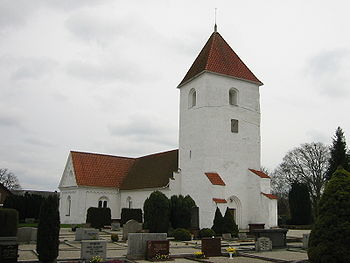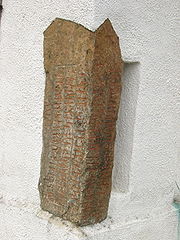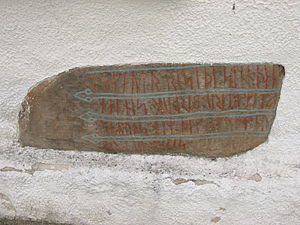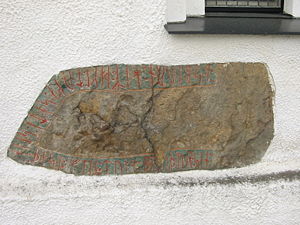
Hällestad Runestones
Encyclopedia

Lund
-Main sights:During the 12th and 13th centuries, when the town was the seat of the archbishop, many churches and monasteries were built. At its peak, Lund had 27 churches, but most of them were demolished as result of the Reformation in 1536. Several medieval buildings remain, including Lund...
in Skåne, southern Sweden
Sweden
Sweden , officially the Kingdom of Sweden , is a Nordic country on the Scandinavian Peninsula in Northern Europe. Sweden borders with Norway and Finland and is connected to Denmark by a bridge-tunnel across the Öresund....
. Their Rundata
Rundata
The Scandinavian Runic-text Data Base is a project involving the creation and maintenance of a database of runic inscriptions. The project's goal is to comprehensively catalog runestones in a machine-readable way for future research...
identifiers are DR 295, 296, and 297. DR 295 is notable because it is held to be raised in memory of a warrior who fell in the legendary Battle of the Fýrisvellir
Battle of the Fýrisvellir
The Battle of Fýrisvellir was a battle for the throne of Sweden which was fought in the 980s on the plain called Fýrisvellir, where modern Uppsala is situated, by Eric the Victorious and his nephew Styrbjörn the Strong...
, near Uppsala
Uppsala
- Economy :Today Uppsala is well established in medical research and recognized for its leading position in biotechnology.*Abbott Medical Optics *GE Healthcare*Pfizer *Phadia, an offshoot of Pharmacia*Fresenius*Q-Med...
, Sweden between the Jomsvikings led by Styrbjörn the Strong
Styrbjörn the Strong
Styrbjörn the Strong was, according to late Norse sagas, the son of the Swedish king Olof, and the nephew of Olof's co-ruler and successor Eric the Victorious, who defeated and killed Styrbjörn at the Battle of Fyrisvellir...
and Styrbjörn's uncle Eric the Victorious, the king of Sweden, c. 985. The other stones were raised by the same people, and they probably formed a monument together in memory of comrades lost in the battle.
DR 295

Sandstone
Sandstone is a sedimentary rock composed mainly of sand-sized minerals or rock grains.Most sandstone is composed of quartz and/or feldspar because these are the most common minerals in the Earth's crust. Like sand, sandstone may be any colour, but the most common colours are tan, brown, yellow,...
runestone, which is walled into the south-western corner of the church of Hällestad, has been known since the late 17th century. The inscription begins in the left row on the front side and follows the boustrophedon
Boustrophedon
Boustrophedon , is a type of bi-directional text, mostly seen in ancient manuscripts and other inscriptions. Every other line of writing is flipped or reversed, with reversed letters. Rather than going left-to-right as in modern English, or right-to-left as in Arabic and Hebrew, alternate lines in...
order of reading. The inscription is dated to the late 10th century, and shows an early dotted k
Kaunan
The k-rune is called Kaun in both the Norwegian and Icelandic rune poems, meaning "ulcer". The reconstructed Proto-Germanic name is *Kaunan. It is also known as Kenaz , based on its Anglo-Saxon name.The Elder Futhark shape is likely directly based on Old Italic c / Latin C...
-rune which represents the g-phoneme in aigi It also contains an unusual dotted m-rune (
 ), which is however only for decorative purposes since it does not change the pronunciation (compare the Transjö Runestone). An interesting detail is the fact that it calls Toki Gormsson "brother", which should be interpreted as "brother-in-arms" and not a biological brother. The Viking Age
), which is however only for decorative purposes since it does not change the pronunciation (compare the Transjö Runestone). An interesting detail is the fact that it calls Toki Gormsson "brother", which should be interpreted as "brother-in-arms" and not a biological brother. The Viking AgeViking Age
Viking Age is the term for the period in European history, especially Northern European and Scandinavian history, spanning the late 8th to 11th centuries. Scandinavian Vikings explored Europe by its oceans and rivers through trade and warfare. The Vikings also reached Iceland, Greenland,...
warbands consisted of brotherhoods, where each member had equal worth, including the warchief who in this case was Toki Gormsson. Toki was probably the son of the Danish king Gorm the Old
Gorm the Old
Gorm the Old , also called Gorm the Sleepy , was the first historically recognized King of Denmark, reigning from to his death . He ruled from Jelling, and made the oldest of the Jelling Stones in honour of his wife Thyra. Gorm was born before 900 and died .-Ancestry and reign:Gorm is the reported...
, who died c. 958 or 959. This Toki is not remembered by the Norse sagas but, unlike the sagas, the runestones constitute contemporary documentation. Also notable is that the stone reports that the men went closest to Toki, meaning that the best warriors formed a shield circle around the warchief during battle in order to show fealty to their leader (compare with the Kålsta Runestone). The hill which is referred to was probably a barrow
Tumulus
A tumulus is a mound of earth and stones raised over a grave or graves. Tumuli are also known as barrows, burial mounds, Hügelgrab or kurgans, and can be found throughout much of the world. A tumulus composed largely or entirely of stones is usually referred to as a cairn...
in which the brothers-in-arms buried Toki according to the traditions of the time.
Transliteration
- A : askil : sati : stin : þansi : ift[iR] ¶ : tuka : kurms : sun : saR : hulan : ¶ trutin : saR : flu : aigi : at : ub:¶:salum
- B satu : trikaR : iftiR : sin : bruþr ¶ stin : o : biarki : stuþan : runum : þiR :
- C (k)(u)(r)(m)(s) (:) (t)(u)(k)(a) : kiku : (n)(i)(s)(t)[iR]
Transcription
- A Æskel satti sten þænsi æftiR Toka Gorms sun, seR hullan drottin. SaR flo ægi at Upsalum
- B sattu drængiaR æftiR sin broþur sten a biargi støþan runum. ÞeR
- C Gorms Toka gingu næstiR.
Translation
- A Áskell placed this stone in memory of Tóki Gormr's son, to him a faithful lord. He did not flee at Uppsala.
- B Valiant men placed in memory of their brother the stone on the hill, steadied by runes. They
- C went closest to Gormr's Tóki.
DR 296

Granite
Granite is a common and widely occurring type of intrusive, felsic, igneous rock. Granite usually has a medium- to coarse-grained texture. Occasionally some individual crystals are larger than the groundmass, in which case the texture is known as porphyritic. A granitic rock with a porphyritic...
. The inscription refers to Erra as Tóki's hemþægi or heimþegi (pl. heimþegar), meaning "home-receiver" (i.e., one who is given a house by another). A total of six runestones in Denmark refer to a person with this title, the others besides DR 296 and DR 297 being DR 1
Stone of Eric
The Stone of Eric, listed as DR 1 in the Rundata catalog, is a memorial runestone that was found in northern Germany. This area was part of Denmark during the Viking Age.-Description:...
, DR 3, DR 154, and DR 155. The use of the term in the inscriptions suggest a strong similarity between heimþegar and the Old Norse term húskarl (literally, "house man"), or housecarl
Housecarl
In medieval Scandinavia, housecarls and sometimes spelled huscarle or houscarl) were either non-servile manservants, or household troops in personal service of someone, equivalent to a bodyguard to Scandinavian lords and kings. This institution also existed in Anglo-Saxon England after its...
. Like housecarls, heimþegar are in the service of a king or lord, of whom they receive gifts (here, homes) for their service. Some, like Johannes Brøndsted
Johannes Brøndsted
Johannes Brøndsted, was a Danish archaeologist and prehistorian.-Biography:Brøndsted was born in Grundfør, Jutland....
, have interpreted heimþegi as being nothing more than a local Danish variant of húskarl.
Transliteration
- : oskautr : ristþi : stin : þansi (:) ¶ (:) (i)ftiR : airu : brþur : sin : ian : ¶ : saR : uas : him:þiki : tuka : nu : ¶ : skal : stato : stin : o : biarki :
Transcription
- Asgotr resþi sten þænsi æftiR Ærru, broþur sin. Æn saR was hemþægi Toka. Nu skal standa sten a biargi.
Translation
- Ásgautr raised this stone in memory of Erra, his brother. And he was Tóki's retainer. Now the stone will stand on the hill.
DR 297

Sandstone
Sandstone is a sedimentary rock composed mainly of sand-sized minerals or rock grains.Most sandstone is composed of quartz and/or feldspar because these are the most common minerals in the Earth's crust. Like sand, sandstone may be any colour, but the most common colours are tan, brown, yellow,...
. It is probably made by the same runemaster
Runemaster
A runemaster or runecarver is a specialist in making runestones.Most early medieval Scandinavians were probably literate in runes, and most people probably carved messages on pieces of bone and wood. However, it was difficult to make runestones, and in order to master it one also needed to be a...
as DR 295. Similar to DR 296, the inscription also refers to Ásbjôrn as being Toki's hemþægi.
Transliteration
- : osbiurn : him:þaki : tuka : sati : stin ¶ : þasi : iftiR : tuka : bruþur : sin :
Transcription
- Æsbiorn, hemþægi Toka, satti sten þæssi æftiR Toka, broþur sin.

